What is ceramic capacitor pcb?
Ceramic capacitors are electronic components that are widely used in various electronic
devices and circuits. They are commonly used for their ability to store and release electrical
energy. A ceramic capacitor PCB refers to a printed circuit board that incorporates ceramic
capacitors as part of its design.
A printed circuit board (PCB) is a flat board made of non-conductive material, such as fiberglass
or composite epoxy, that holds and connects electronic components. It provides mechanical
support and electrical connections for various electronic components, including capacitors,
resistors, transistors, and integrated circuits. PCBs are essential in modern electronics as
they allow for efficient and compact designs.
Ceramic capacitors, on the other hand, are passive electronic components that store and
release electrical energy. They consist of two conductive plates separated by a dielectric
material, which is typically made of ceramic. The conductive plates are usually made of a
metal such as silver or nickel, and the dielectric material provides insulation between the plates.

The capacitance value of a ceramic capacitor is determined by the surface area of the
conductive plates, the distance between them, and the dielectric constant of the ceramic
material. Ceramic capacitors are available in a wide range of capacitance values, voltage
ratings, and sizes, making them suitable for various applications.
When it comes to PCBs, ceramic capacitors are commonly used due to their numerous
advantages. One of the main advantages is their small size. Ceramic capacitors are available
in surface mount packages, which are designed to be directly mounted on the surface of a PCB.
This allows for compact and space-saving designs, making them ideal for modern electronic
devices that require miniaturization.
Another advantage of ceramic capacitors is their high capacitance density. They can provide
high capacitance values in a small package, allowing for efficient energy storage and release.
This is particularly useful in applications where space is limited, such as mobile devices, laptops, and wearables.
Ceramic capacitors also offer excellent stability and reliability. They have low equivalent series
resistance (ESR) and equivalent series inductance (ESL), which means they have low losses
and can handle high-frequency signals effectively. This makes them suitable for applications
that require stable and reliable performance, such as power supplies, filters, and decoupling circuits.

Furthermore, ceramic capacitors have a wide operating temperature range, typically from -55°C
to +125°C. This makes them suitable for use in harsh environments where temperature fluctuations
are common, such as automotive, aerospace, and industrial applications.
In terms of PCB design, ceramic capacitors are typically soldered onto the PCB using surface mount
technology (SMT). SMT allows for automated and precise placement of components onto the PCB,
resulting in high manufacturing efficiency and accuracy. The small size of ceramic capacitors makes
them well-suited for SMT assembly processes.
When designing a PCB that incorporates ceramic capacitors, several factors need to be considered.
The capacitance value and voltage rating of the ceramic capacitors should be selected based on the
specific requirements of the circuit. The physical size and package type of the ceramic capacitors
should also be considered to ensure proper placement and soldering on the PCB.
![]H)~~(%WW3QW]T7K]`_L]Q0](https://www.andwinpcb.com/wp-content/uploads/2023/06/HWW3QWT7K_LQ0.png)
Additionally, the PCB layout should be carefully designed to minimize parasitic effects such
as stray capacitance and inductance. Proper placement of ceramic capacitors near the
components they are intended to decouple or filter is crucial to ensure optimal performance.
In conclusion, a ceramic capacitor PCB refers to a printed circuit board that utilizes ceramic
capacitors as part of its design. Ceramic capacitors offer numerous advantages such as small
size, high capacitance density, stability, and reliability. They are commonly used in various
electronic devices and circuits, and their integration into PCBs allows for efficient and compact
designs. Careful consideration should be given to the selection and placement of ceramic capacitors
to ensure optimal performance and functionality of the PCB.
Other PCB products, you may interesting









